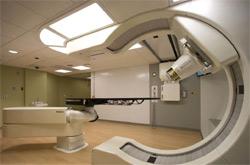
Image courtesy of Siteman Cancer Center
January 14, 2015 — More than 100 cancer patients have received an innovative form of radiation therapy at the S. Lee Kling Center for Proton Therapy in its first year of operation. The treatments, which utilize the world’s first proton system of its kind, are provided at Siteman Cancer Center at Barnes-Jewish Hospital and Washington University School of Medicine in St. Louis.
The new technology delivers the same targeted, noninvasive treatments as conventional proton systems but is considerably smaller in size and costs less.
Since December 2013, the new system:
· Has delivered more than 6,700 clinical proton treatment fields to 118 patients. (One treatment field equals the use of a single proton beam. Each patient receives two or three treatment fields per therapy session.) Of those patients, about 25 percent were children and 75 percent were adults
· Has addressed a variety of complex tumors. Of adult tumors treated, 43 percent were in the brain, 27 percent were in the lungs, 11 percent were in the prostate and 8 percent were in the esophagus
· Has treated more than 20 patients in a single day
A superconducting synchrocyclotron proton accelerator is a key component of the proton therapy system. The relatively small size of the device allows it to fit in a single room that isn’t much larger than a traditional radiation therapy room. The cost of this single-vault proton therapy system was about $25 million. That represents a fraction of the investment needed for traditional proton therapy systems, which typically are housed in football field-sized buildings and cost more than $150 million.
Littleton, Mass.-based Mevion Medical Systems developed and manufactured the technology, called the Mevion S250 Proton Therapy System. Radiation oncologists and physicists at Washington University worked with Mevion to develop and refine the proton therapy technology.
The proton therapy center was named after the late S. Lee Kling, a visionary St. Louisan who traveled to the East Coast to receive proton therapy for an eye tumor. Kling, a former chairman of The Foundation for Barnes-Jewish Hospital’s board of directors, believed the therapy should be more accessible and available to patients in St. Louis. As a result, Kling, along with family and friends, established the S. Lee Kling chair in radiation oncology — held by Bradley — to help lead the proton center’s development and to conduct research into the most effective ways to use this new technology.
The center serves the St. Louis region and the Midwest. The next closest location offering proton therapy is in the Chicago area, about 280 miles away.????????????????????
For more information: www.siteman.wustl.edu
